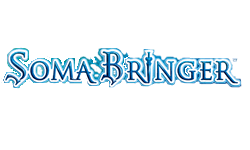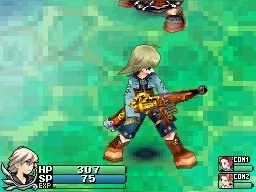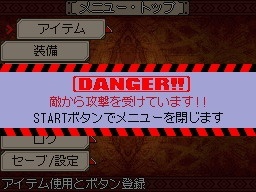|
|

|
PLATFORM
|
DS
|
BATTLE SYSTEM
|

|
INTERACTION
|

|
ORIGINALITY
|

|
STORY
|

|
MUSIC & SOUND
|

|
VISUALS
|

|
CHALLENGE
|
Unbalanced
|
LANGUAGE BARRIER
|
Moderate
|
COMPLETION TIME
|
40-60 Hours
|
|
OVERALL

|
+ Good polygonal modelling.
+ Easy to reallocate ability points.
- Would have looked better on a larger screen.
- Superfluous and redundant level design.
- Tries at philosophy, fails at presentation.
- So much loot, not enough ways to use it.
|
Click here for scoring definitions
|
|
|
Monolith Software is known for its experimental approach, its broad range of style, and its taste for philosophical discourse. Sometimes these things come together to form games that are memorable and loved, but often they fall flat in some way. Soma Bringer appeared on the DS in 2008, but never had a chance to come stateside. That may not be something worth crying over.
The story of Soma Bringer starts on a high note, with a young rookie joining an elite force for his first real mission. The Pharzuph 7th Division is a branch of Secunda Dei, an organization dedicated to maintaining the balance of soma (magic force) in the world as well as combatting the mysterious Visitors that attack from outer space. The usual JRPG tropes emerge, including ancient civilizations, lost races, ominous presences that are almost Lovecraftian in their alienness, and a girl-in-a-box for good measure.
For all this, the story never gels in a satisfactory manner. The eight members of the 7th all have personalities and backstory, but these tend to have little influence outside of specific chapters. Mostly they just add color to proceedings that would have carried on just the same without them. Character interaction is found mainly in the field, often before major battles where people should not be having ten-minute discussions on the nature of reality while giant monsters wait patiently for their turn to smash the heroes. Certain major NPCs contribute to the plot in the first four chapters, but their influence wanes the longer the game goes on, until the primary motivation for the player becomes one of simply plowing through screen after screen of dungeon just to see what happens. The payoff is questionable.
Soma Bringer presents a strong primary plot, but doles it out in large chunks at irregular intervals. Such large information dumps make for difficult digestion, and very little is done to support it or to flesh out the world. Towns are at most a couple of screens with a handful of NPCs who rarely contribute more than the occasional side-quest. It's difficult to form an attachment to any of the locations or characters, even the main cast. For all the heavy symbolism Monolith forces into the final chapters, this is a game designed around its battle system.
 Sure, he looks cool, but you try to aim when none of the enemies can be seen at that level of zoom.
Sure, he looks cool, but you try to aim when none of the enemies can be seen at that level of zoom.
|
|
So how is the combat? Soma Bringer is an action-oriented title with a focus on wide areas and lots of loot. While the player controls the hero, two other members from the squad will tag along. The AI controls are very simplistic, but the allied characters acquit themselves well enough to know when to attack and when to retreat for healing. Unfortunately, aside from the basic AI setting and a choice of fighting style, nothing else about these allies is customizable. There is no way to change their equipment or augment their stats. They're just there to be used. Even their hit points are tied indirectly to the protagonist's level.
In effect, Monolith designed Soma Bringer to be a co-op gaming experience while keeping the story strictly single-player. When starting a game, the player can choose any member of the 7th Division as an avatar, and this character also represents him or her when interacting with another player. The game's story plays out exactly the same regardless of who the player's avatar may be, but it does add some level of variety. Each of the game's character classes has a choice of two weapon types, and the fact that ability points can be reallocated on the fly makes it easy to repurpose the player's hero. Everyone else has a limited moveset, a permanently assigned weapon type, and a vague tactical menu. It's hard to tell when they're even using special skills, sometimes.
This lack of customizability for secondary heroes is compounded by the sheer amount of loot accumulated in even a short period of exploration. Enemies drop all sorts of weapons, armor, and accessories, much of it unusable by the main character no matter which class the player chooses. Each piece of equipment comes with a slot for a soma orb, which can boost various stats and elemental attributes. Again, the player is going to have far more orbs (and cash to buy orbs) than is ever going to be necessary. Even the items that can be equipped are often useless, as it is possible to pick up a really high quality piece of equipment through side-quests and hold on to it for a chapter or two because nothing else can compare. Loot can be traded to other players to ensure that someone will actually use the better bits, but that's about the only alternative to selling it all.
 Almost forgot the part where you can be attacked in the item menu...
Almost forgot the part where you can be attacked in the item menu...
|
|
There is an unfortunate reality that plagues most co-op games, however, and that is availability of partners. Unless the game gains incredible popularity or allows for single-cartridge multiplayer — and this one has done neither — then odds are that most players will have to go through this one solo. With basic, uncustomizable characters and a simple AI, many bosses towards the end of the game become grindy, punishing ordeals that can only be won by whittling down the boss's health, dying or otherwise quitting the area, then coming back refreshed. Enemies do not reset unless the game is turned off, meaning that with a lot of determination any battle is winnable, if very long and frustrating with many involuntary trips back to the local teleporter hub. In that context, the network of soma gates in each region was probably the best implemented feature the game possesses. The fact that it is possible to duck out on the final boss of the game, nip back to base for a quick health restore and some supplies, then return with no penalty is just odd, though.
Each chapter features a wide area to explore. Often there will be multiple zones within that area, and progression through them may hinge on the current plot point. Some chapters feature whole sub-areas that can be explored for extra loot, semi-unique monster encounters, or humongous optional bosses that could only be intended for high-level co-op play. The farther into the game one progresses, the less importance these sub-areas have, however. The final chapter includes an entire floating continent covered by jungle bordering a small inland sea and small archipelago bobbing upon it, but all that does it give the player multiple routes with recycled graphics and several ways to get lost. By that point in the game, there is no impetus to explore, and no secondary goals (aside from that chapter's optional boss) are given to promote exploration. Instead, it turns into a slog through hordes of monsters carrying loot that is probably not worth it. There are times where it seems like the developers made the area huge just for the sake of making it huge, as there doesn't seem to be a point to it all otherwise.
Graphics in Soma Bringer win on two fronts. First, the 3D polygonal models for characters and monsters are very detailed for being on the DS. Second, the prerendered backgrounds are excellent examples of what can be done with sprite-based 2D. It's where the two mix that issues arise — and that would account for more than ninety percent of the game. Due to screen size limitations, the polygonal models are generally too small to be fully appreciated unless the player increases the magnification. There are five magnification settings, with the 2D graphics looking best on the first and the 3D graphics looking best on the fifth. While the character models look great at full magnification, the background becomes a pixelated mess and the game itself becomes practically unplayable by anyone but a pure melée class. Even then, the large size of many bosses means that they are difficult to fight while any level of zoom is in effect. The special attacks, while numerous, do not stand out visually among everything that's already happening on-screen.
 I never did figure out what he was pointing at.
I never did figure out what he was pointing at.
|
|
The sound is about the only thing done unequivocally right in this game. Music is always appropriate to the moment, for example fading into new tracks when semi-unique monsters or bosses are near. Of the various sound effects related to combat, none really stand out, but on the other hand none grate on the nerves either. The clangs, grunts, and death rattles of war were not a major concern in the making of this title. As for the language barrier, that is variable. If one wishes to understand the philosophical points made, then it's high. If one simply wishes to slice and dice monsters, then it's moderate. The only thing that would need to be understood is information pertaining to skills and equipment, and even that can be largely ignored or resolved through a bit of trial and error.
I didn't really care for this game at all, sad to say. I've never had much experience with loot-heavy action RPGs of the dungeon-crawling variety, having merely been a spectator of such in college, but it seems to me that Soma Bringer lacks a certain something that the big names of this sub-genre had in abundance. Issues with customization, superfluous level design, uneven difficulty, and an astounding surplus of unusable loot makes me question what Monolith was actually trying to do here. Certainly, if the developers wanted a vehicle to present a parable on the nature of envy, fear, and retribution, there were better ways it could have been done.
Review Archives
|









